The Apple iPhone 11, 11 Pro & 11 Pro Max Review: Performance, Battery, & Camera Elevated
by Andrei Frumusanu on October 16, 2019 8:30 AM ESTDisplay Measurement
When it comes to displays, last year's iPhone XS didn’t showcase any major display changes compared to the original iPhone X, as the two phones seemingly shared the same display panel. In contrast to that situation, for the new iPhone 11 Pros, Apple is advertising using a newer generation panel which brings notable improvements with it.
In terms of dimensions or resolution, there’s no visible changes on the new panels, and you’d have to look under the hood to see what has actually changed. The most notable improvement this year is a switch in the OLED emitter material that’s been used by Samsung in producing the new screen. The new generation emitter was first introduced in the display panel of the Galaxy S10, and to my knowledge it has subsequently only been used in the Note10 series as well as the new OnePlus 7T (regular version only). The iPhone 11 Pro phones now join this limited group of devices, and the biggest improvements to the user experience will be higher maximum brightness levels as well as improved power efficiency.
The regular iPhone 11, on the other hand does not seem to have changed much from the iPhone XR. It remains a relatively lower resolution LCD screen, although its display characteristics remain excellent.
We move on to the display calibration and fundamental display measurements of the iPhone 11 screens. As always, we thank X-Rite and SpecraCal, as our measurements are performed with an X-Rite i1Pro 2 spectrophotometer, with the exception of black levels which are measured with an i1Display Pro colorimeter. Data is collected and examined using SpectraCal's CalMAN software.

In terms of maximum brightness, Apple has advertised that the new iPhone 11 Pro’s can reach up to 800nits of brightness displaying regular content. We’re able to verify this, as our 11 Pro Max sample reached 807 nits while the 11 pro reached 790 nits. Consequently, it’s quite odd to see that the LCD-based iPhone 11 is now the lowest brightness device in the line-up. As always, Apple doesn’t make use of any brightness boost mechanism and thus allows its peak brightness to be achieved in any scenario.
Apple also advertises that the screen does go up to 1200 peak brightness in HDR content, however I haven’t been able to go ahead to verify this in our current test suite.
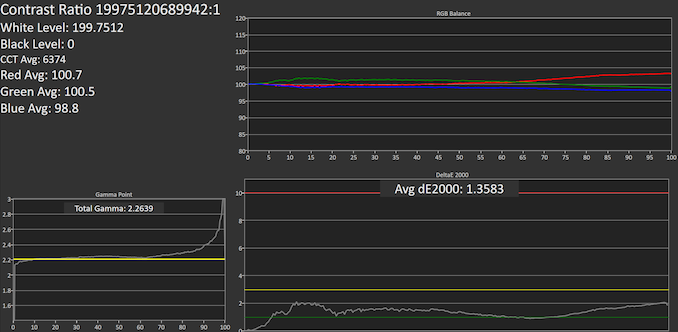
SpectraCal CalMAN
iPhone 11:
iPhone 11 Pro:
iPhone 11 Pro Max:
In the greyscale tests, all the iPhones perform extremely well, as expected. The Pro models do showcase a tendency to have slightly too strong red levels, so their color temperature is ever so slightly too warm. This characteristic diminishes the higher in brightness we go on the Pro models. The iPhone 11 has a weakness in the greens, so its color temperature is a above the 6500K white point target.
Gamma levels are excellent and target levels of 2.2. The Pro models are veering off towards higher gamma at higher picture levels, something that isnt as prominently exhibited by the iPhone 11. I’m not sure if this is due to a non-linear APL compensation of the phone screen during our measurement patterns, or if there’s an actual issue of the calibration.

iPhone 11 / SpectraCal CalMAN
iPhone 11 Pro / SpectraCal CalMAN
iPhone 11 Pro Max / SpectraCal CalMAN

The dE2000 deviation scores for the Pro models this year are slightly worse than what we saw in last year’s XS devices, however it’s still firmly among the best in class devices out there in the market, and you’d be hard pressed to perceive the small deviations. The iPhone 11 oddly enough does fare a bit worse off than the iPhone XR due to the larger deviations in color balance.
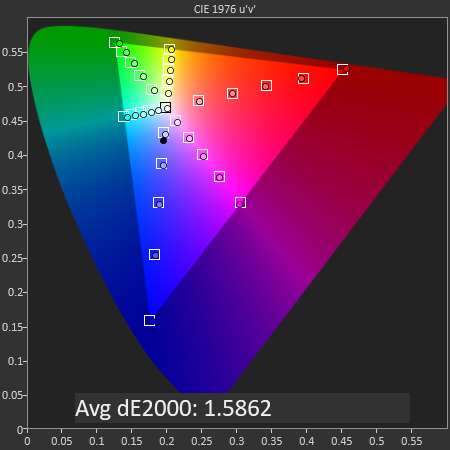
iPhone 11 / SpectraCal CalMAN
In the sRGB color space (default device content), the iPhone 11 performs extremely well with only minor shifts in hue in the greens.
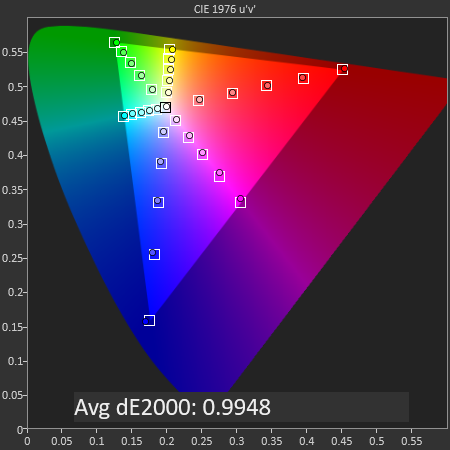
iPhone 11 Pro / SpectraCal CalMAN
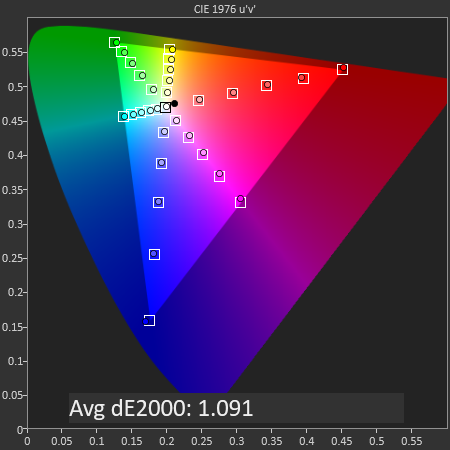
iPhone 11 Pro Max / SpectraCal CalMAN
In the same test, both the Pro models are showcasing exemplary accuracy.

The Pro models are just a bit worse off than the XS models of last year, but again these are among the most accurate displays you’ll find out there – mobile devices or not. The iPhone 11 is still excellent, although showing a bit larger deviation compared to the XR.
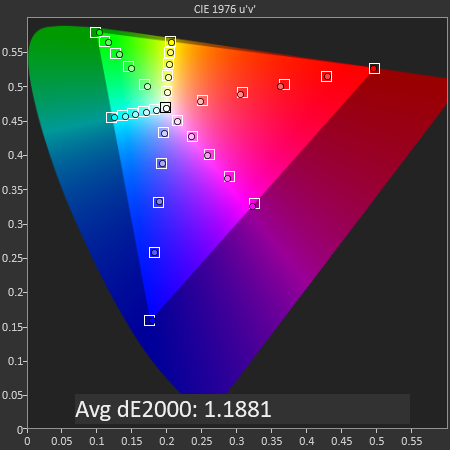
iPhone 11 / SpectraCal CalMAN
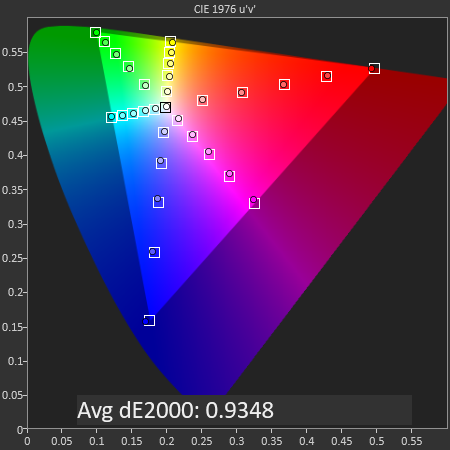
iPhone 11 Pro / SpectraCal CalMAN
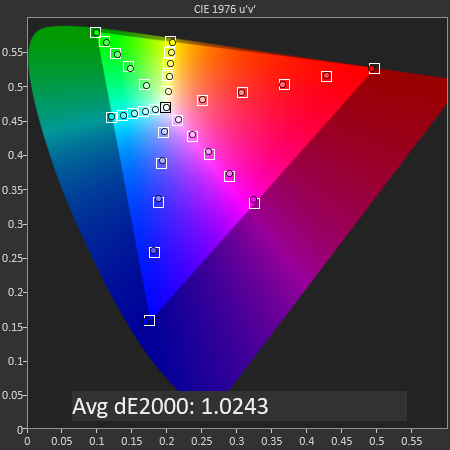
iPhone 11 Pro Max / SpectraCal CalMAN
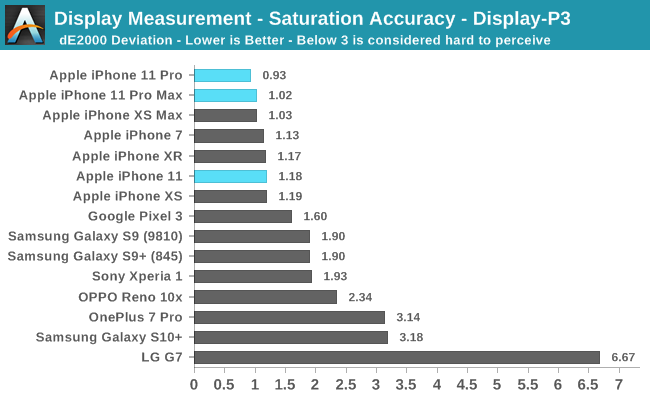
For Display P3 content, the iPhone 11 Pro models showcase the best saturation accuracies we’ve ever measured on any display. This time around, the iPhone 11 is in line with the XR.
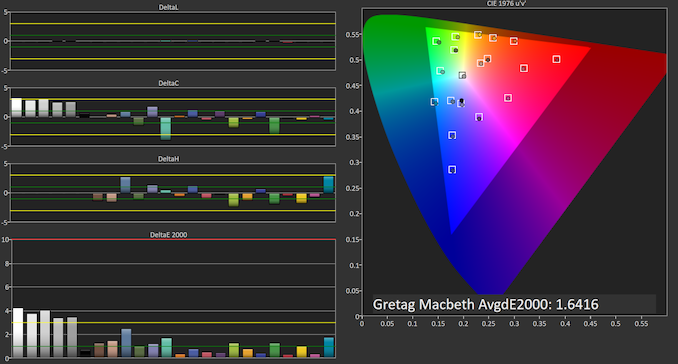

iPhone 11 / SpectraCal CalMAN
In the Gretag-MacBeth test of common tones, the only real issue of the iPhone 11 is the whites which had showcased a weakness of greens. Notice how the luminosity of the tones are essentially absolutely perfect.


iPhone 11 Pro / SpectraCal CalMAN
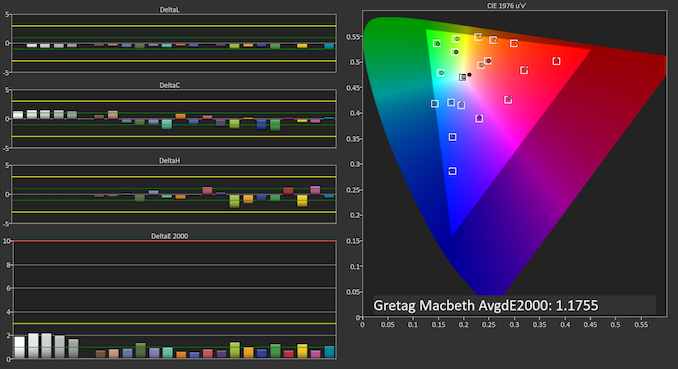

iPhone 11 Max Pro / SpectraCal CalMAN

Overall in terms of the color calibration and screen quality, the iPhones are the very best in the industry. There’s really nothing I can say about them as they’re class-leading in every regard.
The iPhone 11’s LCD screen isn’t for my taste due to the lower resolution, which frankly does bother me, and it certainly doesn’t have the same contrast characteristics as the Pro models. So while colors are still extremely good, it remains a compromise in 2019 when essentially every manufacturer has moved on to adopt OLED screens.
Display Power Measurements - Generational Improvements
Naturally, we didn’t want to finish the display evaluation section without verifying Apple’s claims about the new improved power efficiency of the iPhone 11 Pro panels.
Comparing the three generations of identical format iPhones, we again see that the display power consumption between the original iPhone X and the XS didn’t differ much at all. Plotting the new iPhone 11 Pro in the chart however we immediately see the difference in the new generation.
At equal brightness levels, Apple has indeed been able to improve the power efficiency of the panel by 15% - just as Apple’s marketing described it. We also see how the new panel expands past the brightness limits of the X and XS, reaching 800nits. This does come at a cost however, as the improved power efficiency isn’t able to completely make up for the larger brightness increase, so the maximum power consumption of the screen displaying full white does rise from 2.6W to 3.1W.


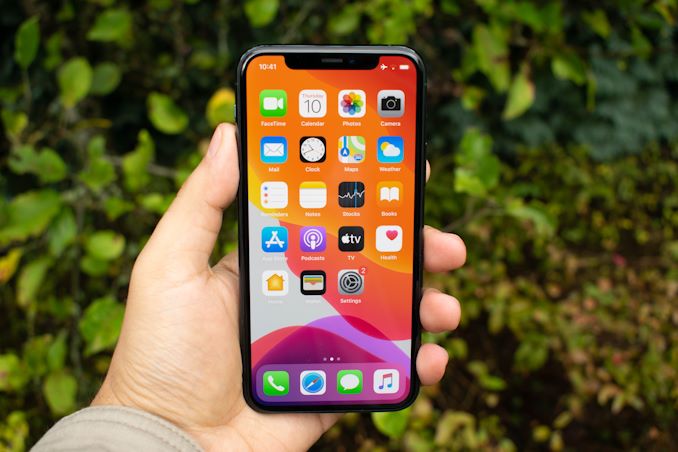









242 Comments
View All Comments
FunBunny2 - Thursday, October 17, 2019 - link
"I wonder which workloads can it possibly affect."lots and lots of software fake floating point arithmetic by scaling integer arithmetic. way faster, even counting the need to shift the decimal point.
MrCommunistGen - Wednesday, October 16, 2019 - link
Bravo Andrei and team! Technical acumen in the article top notch as usual.I'm quite happy with the improvements to writing/editing that have happened over the past year(s?). In this piece the writing was clear to understand almost entirely throughout. In the past, although I was always able to discern the meaning and intent of the content it was sometimes a struggle.
As for the iPhones themselves: Apple's technical silicon expertise does not cease to amaze me. Their absolute performance as well as efficiency are incredible. I'm not sure that this level of excellence is possible on the Android side of things. Since Apple is vertically integrated they're not nearly as constrained on die size as companies who are consumers of ARM's chip designs. Also, they've clearly made an enormous investment in their SoC team, not just financially, but in expertise as well as effective inter/intra team collaboration.
It is somewhat deflating to see that in many metrics the Snapdragon 855 is only on par with the A10 SoC from the iPhone 7. As someone likely looking for a 2020 Android device, I have more than a little silicon envy -- and the reasonable (in today's market at least) price of the base iPhone 11 makes it quite compelling compared to Android flagships.
jrs77 - Wednesday, October 16, 2019 - link
Now make it as small as an iPhone SE and you might have another customer. I'm not buying a phone that I can't even carry in my trousers pockets.yetanotherhuman - Wednesday, October 16, 2019 - link
The 3 camera layout is more than ugly, though, it's actually revolting. As in, it invokes disgust.Xyler94 - Thursday, October 17, 2019 - link
It's a good thing you view the phone from the front about 95% of the time, huh? :)anonomouse - Wednesday, October 16, 2019 - link
Andrei, is the power/voltage curve for the A12 charting power on the CPU rail only, or for the whole system? Since the voltage is presumably just the CPU power rail.Andrei Frumusanu - Wednesday, October 16, 2019 - link
Total system active power, only the top point is measured, the rest is inferred/approximated. It's not exact but it's not meant to be, the point was to show that the CPU gets a lot more efficient at slightly lower clocks.anonomouse - Wednesday, October 16, 2019 - link
Presumably a lot of that total system power is coming from DRAM/SoC though, so that part wouldn't scale the same way/at all with CPU voltage. Not trying to debate the point that the CPU will absolutely be more efficient below that, but the steepness of the system power curve would be probably be less steep.anonomouse - Thursday, October 17, 2019 - link
Also, did you ever get a chance to measure how large the power efficiency improvements the Exynos 9825 on 7LPP had (CPU/GPU) as compared to the 9820?Andrei Frumusanu - Thursday, October 17, 2019 - link
I still don't have an 9825. Generally the consensus seems to be 15%.